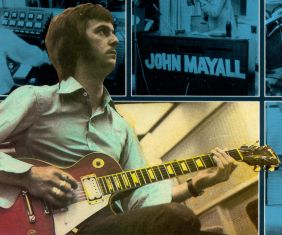
The Guitar That Changed the World
By Jeffrey Aarons

 |
The Guitar That Changed the World By Jeffrey Aarons |
 |
In April 1966, Eric Clapton set the electric plectrum guitar world on fire when he cranked up his Les Paul standard through a Marshall combo and unleashed the first high tech, fluidly dynamic, virtuoso tour de force of electrified guitar blues.
"All Your Love" begins the famous 'Beano' album, with Eric whipping up the G string with that vicious picking attack and launching into his first theme riff of the album featuring that thick, blistering, yet sweet, Les Paul/Marshall sound with his characteristic Lead toggle switch position in place. His vibrato is lush and fierce even though not as refined as it would get a year later. Eric's playing style is un-inhibited and mean, featuring his patented variable picking pressure that articulates notes unlike any player before him. His play featuring speed, control, passion and architecture with such mastery that it would reach the shores of the US like a bomb shell, riveting the ears of wanna be and accomplished blues-rock players alike.

Note the white PAFs
This album shook up Jimi Hendrix and inspired him to take up Chas Chandlers offer to export himself to England (making a condition to meet Eric Clapton). As we can guess, the Bluesbreaker LP inspired Hendrix to reach new heights of competitiveness himself. When Mike Bloomfield, of Paul Butterfield Blues Band, Americas preeminent white blues guitar man first heard the Beano Album he was so enthralled and intimidated, he made a special trip to Britain just to witness this guitar wonder in person. Bloomfield stated, in an interview years ago, he watched Clapton with amazement and was so shook up he claimed "after seeing Clapton on stage, I couldn't play anymore" Bloomfield went on to say that Eric had achieved the quintessential heights of blues guitar and surpassed anything he could imagine being done in the blues idiom. (Bloomfield also said similar things about Jimi and seems to have been perpetually insecure about his own brilliant talent.)
"Stepping Out" and "Hideaway" feature an aggressive Clapton tearing up the fret board with precision control and tasty ferocity. "Stepping Out" became a show piece staple of Cream's live show. I was fortunate enough to witness Clapton blast this tune for close to a solid 40 minutes at the Electic Factory, probably one of his record length versions. "Hideaway", is an example of how he would not only interpret an instrumental, but take it miles beyond. Freddy King's original is good an' soulful, but extremely primitive and almost banal when compared toEC's fiery, high tech passionate explosion in the key of E.
This LP literally was the seminal point for legions of guitarists looking for a guitar bible to learn blues/rock guitar from. It so inspired guitarists, that most aspiring players would make it mandatory to sit down and try to learn all of the solos on this LP. There is no doubt that EC went into the studio to make his mark but, unintentionally, created a Frankenstein that would only be surpassed by his majestic improvising pinnacle during Cream.
The basic Bluesbreaker "style" always remained at the foundation of Clapton's technique and passion. His Bluesbreaker phrasing and technique was the absolute precursor to the more refined and architecturally brilliant Cream style. One can now hear the Bluesbreaker style develop in a linear manner, evolving from "Fresh Cream" to "Disraeli", through the live performances and reaching its pinnacle maturity during theWinterland/Fillmore phase of early 1968. This guitar evolution is even more evident when one listens to Claptons guitar metamorphous throughout each live concert featuring a guitar that perfects the art of blues/rock soloing beyond anything that preceded it or would come after. Clapton singulary defined the art of electric Blues/Rock solo guitar.

Fresh Cream Sessions: The Bluesbreaker Prelude
© Jeffrey Aarons, 1999